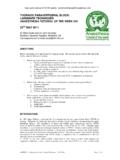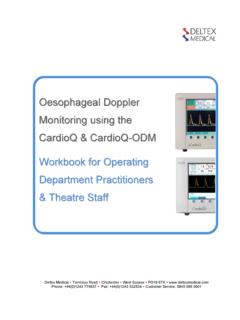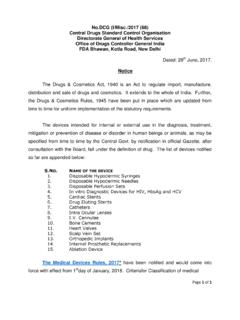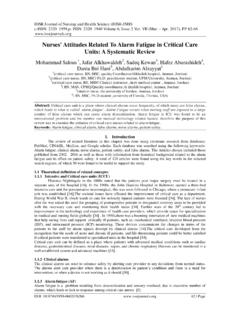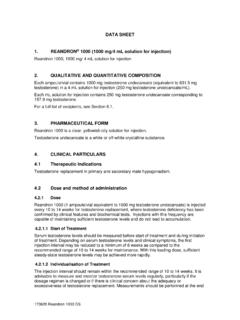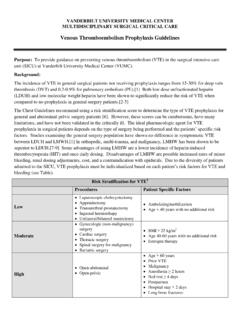Transcription of ANAESTHESIA IN PREGNANCY FOR NON …
1 Sign up to receive ATOTW weekly - email IN PREGNANCY FORNON-OBSTETRIC SURGERY ANAESTHESIA TUTORIAL OF THE WEEK 185 28TH JUNE 2010Dr. Alison HoolCentral Manchester Foundation TrustCorrespondence to QUESTIONS (True / False)Before reading this tutorial, try to answer the following questions. The answers can be found at the end of the Non-obstetric surgery in PREGNANCY :-a) occurs in approximately 5% b) appendicectomy is the most common procedure performedc) is associated with increased congenital abnormalitiesd) is associated with increased spontaneous abortione) laparoscopy is contraindicated2. During PREGNANCY :a) MAC decreases by 10%b) plasma cholinesterase levels increasec) suxamethonium has a clinically prolonged duration of actiond) platelet consumption decreasese) Functional Residual Capacity (FRC) may be less than alveoli closing volume3. Concerning foetal safety during non-obstetric surgery: a) teratogenicity is the most serious riskb) hyperoxia is not dangerousc) foetal heart rate monitoring perioperatively improves foetal outcomed) ketamine is the anaesthetic drug of choicee) maternal hypercarbia should be avoidedINTRODUCTIOND uring PREGNANCY , surgery for non-obstetric procedures occurs in up to 2% of women.
2 This figure may be considerably higher in the first trimester as PREGNANCY may go undetected at the time of surgery. Approximately 42% of procedures occur in the first trimester, 35% during the second and 23% during the range and incidence of procedures are similar to the non-pregnant group of young women. Acute abdominal problems are most common, with appendicectomy ranking first followed by cholecystectomy. PREGNANCY predisposes to cholelithiasis and approximately 3% of pregnant women develop gallstones, however only a limited number require surgery. Other common problems include adnexal disease ( ovarian cysts which may rupture or become torted) and trauma. Much less ATOTW 185 ANAESTHESIA in PREGNANCY for non-obstetric surgery 28/06/10 Page 1 of 9 Sign up to receive ATOTW weekly - email are cardiovascular or neurological emergencies. The demands of PREGNANCY on the cardiovascular system can cause decompensation of valvular heart disease or precipitate aortic dissection.
3 Anaesthetists who care for pregnant patients undergoing non-obstetric surgery must provide safe ANAESTHESIA for both the mother and the foetus. To maintain maternal safety the physiological and anatomical changes of PREGNANCY must be considered and anaesthetic techniques and drug administration modified accordingly. Foetal wellbeing is related to avoidance of foetal asphyxia, teratogenic drugs and preterm SAFETYP hysiological / anatomical changesCardiovascular changesMaternal cardiac output increases in PREGNANCY by 50% and peaks by the end of the 2nd trimester. This is due to a combination of an increased heart rate (25%) and stroke volume (30%). The increase in heart rate is a reflex response to a lowered systemic vascular resistance (SVR) caused by circulating oestrogen and progesterone. Left ventricular hypertrophy and dilatation facilitate the increase in stroke volume but myocardial contractility remains changes that occur in PREGNANCY and are entirely normal include left axis deviation and minor ST / T wave changes.
4 Heart murmurs are also common due to turbulence associated with increased blood flow. As the enlarging uterus moves out of the pelvis it can compress the inferior vena cava and the descending aorta in the supine position. The compression of the inferior vena cava causes decreased venous return and hence preload, which reduces cardiac output by up to 20%. This is known as supine hypotension syndrome. Pregnant patients compensate for hypotension by an increase in sympathetic tone causing vasoconstriction and tachycardia. This may divert blood away from organs such as the uterus, with subsequent foetal distress. The compression of the aorta can cause a further reduction in uterine blood flow. Aortocaval compression becomes clinically relevant from approximately 20 weeks gestation. It can be relieved by a left lateral tilt of 15 degrees, which is therefore essential in all pregnant patients in the supine position after 20 weeks.
5 This is especially important to remember when a patient is under regional ANAESTHESIA /analgesia since hypotension may be potentiated by a sympathetic block. There is an increase in blood volume in PREGNANCY of between 35-50% at term. There is both an increase in plasma volume and red cell volume, but a greater increase in plasma volume which leads to a dilutional anaemia. The reduced blood viscosity aids flow through the uteroplacental circulation and the increase in volume serves as a protective measure against haemorrhage at delivery. It must be remembered that because of the increase in blood volume, along with a resting tachycardia, there may be delay in the onset of the classical symptoms and signs of is a hypercoaguable state with an increase in most clotting factors. The platelet count may fall but there is actually an increase in production and consumption. PREGNANCY is a significant risk factor for thromboembolism and therefore thromboprophylaxis is essential in the postoperative period when the risk is further increased by immobility and the hypercatabolic state.
6 ATOTW 185 ANAESTHESIA in PREGNANCY for non-obstetric surgery 28/06/10 Page 2 of 9 Remember left lateral tilt to prevent aortocaval compression Remember meticulous pre-oxygenation to prevent hypoxia Remember antacid prophylaxis and rapid sequence induction to reduce risk of aspiration Sign up to receive ATOTW weekly - email changesThe respiratory changes of PREGNANCY are perhaps the most important for anaesthetists to note. There is an increased oxygen demand of up to 60% at term. This is met by an increased cardiac output and an increase in minute ventilation (MV). MV increases early due to an increase in respiratory rate and tidal volume and is up by 45% by term. This increase in MV is mediated by progesterone which acts as a respiratory stimulant. The increased MV causes a mild respiratory alkalosis (PaCO2 decreases by 1kPa). The increase in pH is limited by increased renal bicarbonate excretion.
7 Relative hypocapnia should be maintained when artificially ventilating pregnant patients. An increase in maternal PaCO2 limits the gradient for CO2 diffusion from foetal to maternal blood leading to foetal functional residual capacity (FRC) is the main oxygen reserve in the apnoeic patient and is decreased in PREGNANCY due to the enlarging uterus displacing the diaphragm upwards. This is further exacerbated in the supine position and increases as the PREGNANCY progresses. Airway management may be challenging during PREGNANCY . Bag-mask ventilation may be more difficult due to increased soft tissue in the neck. Laryngoscopy can be hindered by weight gain and breast engorgement. Increased oedema of the vocal cords due to increased capillary permeability can hinder intubation and increase the risk of bleeding. This may make further attempts at intubation more difficult and increase the incidence of failed intubation.
8 Increased maternal oxygen consumption and reduced FRC results in rapid oxygen desaturation during attempts at intubation. Smaller sized endotracheal tubes may be needed and all anaesthetists should be familiar with a failed intubation drill. Nasal intubation should be avoided due to increased vascularity of mucous the combination of these changes, careful pre-oxygenation is essential prior to induction of ANAESTHESIA . This should be confirmed if possible by monitoring the end tidal oxygen fraction. In a well pre-oxygenated patient this should be > Pre-oxygenation can be less efficient in the term parturient in the supine position because the closing volume of the alveoli may be greater than the FRC. Pre-oxygenation in a slightly head up position may help changesCirculating progesterone reduces the lower oesophageal sphincter (LOS) tone, increasing the incidence of oesophageal reflux.
9 This is further exacerbated by anatomical changes. The gravid uterus is displaced upwards and to the left pushing the intra-abdominal part of the oesophagus into the thorax in most pregnant women. This often makes the LOS incompetent and lowers the barrier pressure. These factors, along with a lowered stomach pH, increase the risk and severity of aspiration pneumonitis under general ANAESTHESIA . It is recommended that from 16 weeks gestation patients undergoing general ANAESTHESIA should be given prophylaxis against aspiration pneumonitis. This usually includes a non-particulate antacid such as sodium citrate 30ml and an H2 receptor antagonist ranitidine 150 mg orally or 50mg intravenously. Some anaesthetists may also choose to give a prokinetic such as metoclopramide. Induction of ANAESTHESIA should be by a rapid sequence technique with cricoid pressure and a fast acting muscle relaxant such as suxamethonium.
10 A cuffed endotracheal tube should be used. At the end of the procedure patients should be extubated fully awake in the lateral position. ATOTW 185 ANAESTHESIA in PREGNANCY for non-obstetric surgery 28/06/10 Page 3 of 9 Sign up to receive ATOTW weekly - email Altered pharmacokinetics / pharmacodynamicsPharmacokinetic and pharmacodynamic profiles are altered in PREGNANCY and drugs should be titrated minimum alveolar concentration (MAC) of volatile agents is reduced by 30% under the influence of progesterone and endogenous endorphins. There is a decrease in plasma cholinesterase levels by 25% from early PREGNANCY , but prolonged neuromuscular blockade with suxamethonium is uncommon due to increased blood volume causing an increased volume of distribution. Non-depolarising muscle relaxants have a prolonged duration of action. Neuromuscular monitoring with a nerve stimulator is increased blood volume causes a physiological hypoalbuminaemia.









